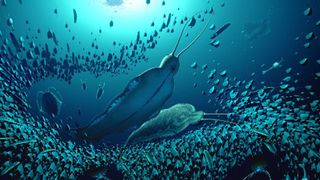'Terror beast' fossils unearthed in Greenland are more than half a billion years old
Enormous for its time period, this newly discovered marine worm likely ruled the seas at the top of the food chain.

A "terror beast" marine worm with a giant jaw dominated the seas more than 500 million years ago, exquisitely preserved fossils show.
Scientists recently uncovered the fossils of the newfound species of carnivorous worm — named Timorebestia koprii, or "terror beast" — in northern Greenland and described it in a study published Wednesday (Jan. 3) in the journal Science Advances.
Existing during the early Cambrian period (541 million to 485.4 million years ago), the predator had a row of fins flanking each side of its body and a pair of long antennae. It could grow to be up to 12 inches (30 centimeters) long, making it one of the largest swimming animals in its time period, according to the study.
Related: 500 million-year-old worm with 'shuriken' spikes named after gigantic 'Dune' sandworms

"Timorebestia were giants of their day and would have been close to the top of the food chain," Jakob Vinther, a paleontologist at the University of Bristol in England, said in a statement. "That makes it equivalent in importance to some of the top carnivores in modern oceans, such as sharks and seals, back in the Cambrian period."

Discovered in sediments known as the Sirius Passet formation of Greenland, some of the Timorebestia samples were so well preserved that the scientists could analyze the worms' digestive systems to determine some of what these carnivores were eating when they died. Most of the prey present in the worms' guts were marine bivalved Cambrian arthropods known as Isoxys.The scientists even discovered one fossil worm with an Isoxys still in its jaw region.
Isoxys were "very common at Sirius Passet and had long protective spines, pointing both forwards and backwards," to help them avoid being eaten, study co-author Morten Lunde Nielsen, a former doctoral student at the University of Bristol, said in the statement. "However, they clearly didn't completely succeed in avoiding that fate, because Timorebestia munched on them in great quantities."
Sign up for the Live Science daily newsletter now
Get the world’s most fascinating discoveries delivered straight to your inbox.
By bombarding the T. koprii samples with a beam of electrons, the scientists revealed a nerve center on their belly known as the ventral ganglion. The presence of this nerve bundle, which likely helped the worms control their locomotory muscles, is unique to a living group of tiny marine worms known as arrow worms, or chaetognaths. This shows that the T. koprii are distant relatives of modern-day chaetognaths, the study authors wrote. However, one of the key differences between these ancient worms and living chaetognaths is the location of their jaws.
"Today, arrow worms have menacing bristles on the outside of their heads for catching prey, whereas Timorebestia has jaws inside its head," study co-author Luke Parry, a paleobiologist at Oxford University, said in the statement. "Timorebestia and other fossils like it provide links between closely related organisms that today look very different."

Kiley Price is a former Live Science staff writer based in New York City. Her work has appeared in National Geographic, Slate, Mongabay and more. She holds a bachelor's degree from Wake Forest University, where she studied biology and journalism, and has a master's degree from New York University's Science, Health and Environmental Reporting Program.
Most Popular


